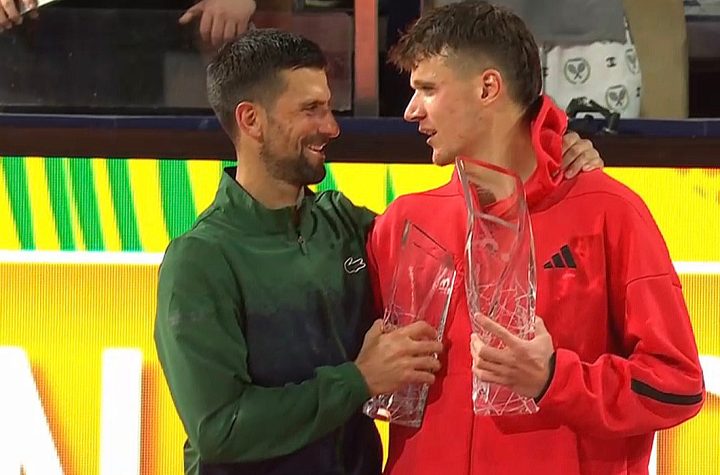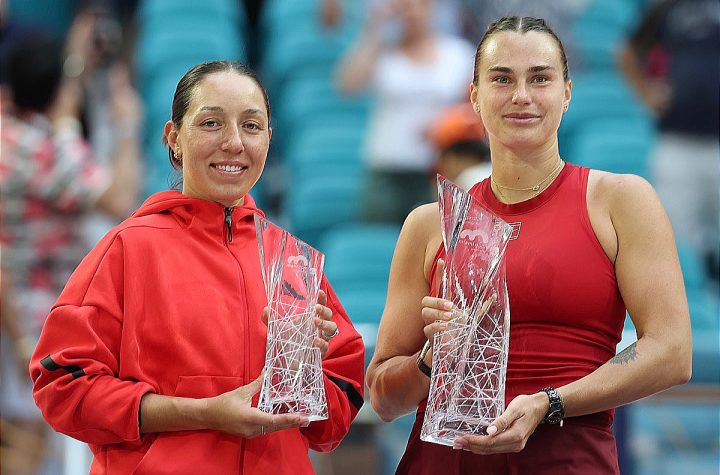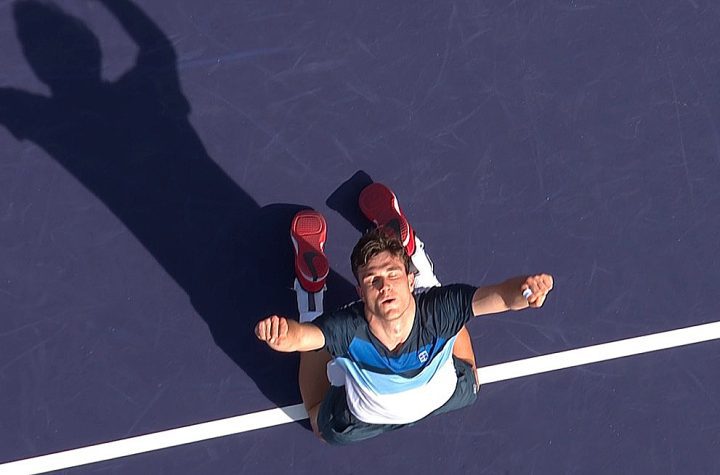
Djokovic wins in Tel Aviv, but stays put at No. 7
–
With three separate 250 events on the schedule last week, there were opportunities for many players to make points.
That included Novak Djokovic, in a rare appearance in a 250 outside the one he owns in Belgrade. And Djokovic made good.
In Seoul, Yoshihito Nishioka was “super-annoying” (to coin a Shapovalov phrase) when he defeated the Canadian in the final.
And in Sofia, where Holger Rune got to the final after No. 1 seed Jannik Sinner tumbled late in their semifinal match and had to retire, the Dane was shocked by unseeded swiss Marc-Andrea Huesler in the final.
So … lots of moves.
For the complete, updated ATP Tour rankings, click here.
ATP Tour Rankings Report – As of Oct. 3, 2022
Rafael Nadal (ESP): No. 3 =========> No. 2 (Casper Ruud drops points from last year’s title in San Diego, so Nadal is back to No. 2. And that means the top two players on the ATP Tour are Spaniards. At least for this week).


Marin Cilic (CRO): No. 16 =========> No. 14 (The Tel Aviv finalist moves to his highest ranking since May, 2019).
Denis Shapovalov (CAN): No. 24 =========> No. 22 (The Canadian ran up against the pesky Nishioka in the Seoul final. But it was still a great week for him, and he moves up two spots).
Holger Rune (DEN): No. 31 =========> No. 26 (You’d have expected Rune to win in Sofia, faced with unseeded Marc-Andrea Huesler in the final. But the Swiss prevailed, limiting Rune’s rise to five spots. It still ties his career best, reached a couple of months ago).

Yoshihito Nishioka (JPN): No. 56 =========> No. 41 (Nishioka had a heck of a week in Seoul, capped off by the second title of his career. As it happens, his first came in Shenzhen in 2018, where he defeated Shapovalov along the way. Last week – same deal. It’s a new career high for him).

Constant Lestienne (FRA): No. 68 =========> No. 61 (The 30-year-old made it to the Tel Aviv semifinals, and gets to another career high in his (relative) tennis dotage and despite having played zero matches at the ATP level before two weeks ago in San Diego).
Marc-Andrea Huesler (SUI): No. 95 =========> No. 64 (A tremendous effort for the 26-year-old to win in Sofia. Needless to say, a career high and super motivating for the the rest of the year).
Roman Safiullin (RUS): No. 104 =========> No. 92 (The 25-year-old reached the semis in Tel Aviv, taking Novak Djokovic to a second-set tiebreak before succumbing. It’s a career high for him. And if his year, which early on looked as though it might be an “Aslan Karatsev in 2021” kinda thing, hasn’t quite worked out that way, he’s still playing the best tennis of his career).
Marco Cecchinato (ITA): No. 137 =========> No. 114 (Cecchinato, the former Roland Garros quarterfinalist and the world No. 16 just 3 1/2 years ago, wins the Challenger in Lisbon and makes a dent in a quest to avoid the qualifying in Australia in January).
Gregoire Barrere (FRA): No. 153=========> No. 116 (Barrere, 28, wins the Orléans Challenger, which is a top-level Challenger offering 125 ranking points to the winner).
Aleksandar Vukic (AUS): No. 144=========> No. 129 (The 26-year-old’s run to the quarterfinals in Sofia earns him a big jump).


Vasek Pospisil (CAN): No. 149 =========> No. 136 (A good step upwards for the Canadian, who qualified and played top-level ball in a quarterfinal loss to Djokovic in Tel Aviv. He’s in the Mouilleron-le-Captif Challenger this week, to play Hugo Grenier in the first round).
Juan Manuel Cerundolo (ARG): No. 178 =========> No. 148 (Cerundolo, still only 20, was at a career high of No. 79 in January, which came a year after he went from the qualifying to the title at the ATP 250 in Cordóba. But injuries have crushed him since then. So the win at the Buenos Aires Challenger last week will do him a lot of good).

Liam Broady (GBR): No. 174=========> No. 150 (Broady had to qualify in Tel Aviv, and did. And then he got to the quarterfinals to get himself back into the top 150).
Dominic Thiem (AUT): No. 173 =========> No. 162 (Slowly but surely for the Austrian, who lost to Cilic in the Tel Aviv second round).
Aleksandar Kovacevic (USA): No. 222 =========> No. 167 (The 24-year-old New Yorker leaps to a new career high, as he went from being a lucky loser to a semifinalist in Seoul).

Luca Van Assche (FRA): No. 289 =========> No. 231 (A big leap for the 2021 Roland Garros junior champion, who reached the final of the Lisbon Challenger at just 18 years old).
ATP Tour Rankings Report – As of Oct. 3, 2022
Casper Ruud (NOR): No. 2 =========> No. 3 (The Norwegian’s ride at No. 2 didn’t last that long, as he lost in the quarterfinals in Seoul, while the points from his win in San Diego last fall fall off. The No. 1 seed in Tokyo, he plays Jaume Munar in the first round. And with Nadal idle, he could well squeeze past him again in a week’s time).

Jannik Sinner (ITA): No. 10 =========> No. 12 (Sinner was forced to retire in the semis in Sofia, and so he couldn’t quite make up his points from winning the event last year. Sinner also has points to defend from winning Antwerp last year coming up for renewal, as well as a fourth round at Indian Wells and a semifinal in Vienna. He was forced to withdraw from Tokyo this week, which is an opportunity lost to make up 500 points).
Gael Monfils (FRA): No. 33 =========> No. 38 (Monfils hasn’t played since injuring himself in the third round in Montreal, forcing a retirement against Jack Draper. At this point, he’s probably waiting to make that drive to the hospital, with the suitcase by the door).
Filip Krajinovic (SRB): No. 42 =========> No. 52 (Idle last week, the Serb drops his semifinal points from last year’s Sofia tournament).
Hugo Dellien (BOL): No. 77 =========> No. 89 (The Bolivian, whose career high of No. 64 came in August, hasn’t played since the first round of Wimbledon. After notably straight-setting Dominic Thiem in the first round of Roland Garros, he lost four straight matches before going on the shelf).

Thanasi Kokkinakis (AUS): No. 80 =========> No. 91 (Kokkinakis drops points from reaching a Challenger final in Romania a year ago. This week, rather than facing No. 2 seed Cameron Norrie in Tokyo, he ends up with No. 9 Borna Coria. He’s also the top seed in doubles with mate Nick Kyrgios).
ATP Tour Rankings Report – As of Oct. 3, 2022

ATP Tour Rankings Report – As of Oct. 3, 2022

ATP Tour Rankings Report – As of Oct. 3, 2022





Could you please explain, because for the life of me, I can’t figure it out, how Djokovic is still in the Top 10? He did not receive any points for winning Wimbledon because no one received any points, & he was the defending champion, so he should have lost a ton of points. I can’t remember what hard court lead-up tournaments in North America he played last year, but he must have played some, & lost points there. Then, he received no points for the US Open when he was a finalist last year, again losing a ton of points. Both Radacanu & Leylah Fernandez had big drops in the rankings for not making the US Open final this year after their runs last year, so why is it different for Djokovic? Tks.
The difference between him and those two is that they weren’t at the very, very top. As well, in Raducanu’s case, a huge chunk of her points were from that US Open win. Same for Fernandez, although obviously not as extreme.
There are pretty big gaps within the top 10, as you see can if you look at the complete rankings. And Djokovic had a pretty massive lead when all this started.
Djokovic is only 3,000 behind No. 1 right now (but No. 1 only has 6700 points).
That’s a Grand Slam and another Slam final, or a Slam title and a Masters 1000 title. That’s actually a LOT to make up – even if the players ahead of you didn’t earn a single point. So even though it “seems” like his ranking is very high, he’s a long way from where he was at the beginning of the season.
At the beginning of 2022, as No. 1, Djokovic had … 11,540 points. That’s literally “two Slam titles” ahead of what Alcaraz has as the No. 1 player now.
Tells you how far ahead he was. He has 8,000 fewer points today, than he did in January. They all expired.
No. 2 at the time, Medvedev, was a full 3,000 points behind him.
No. 7 at the time (which is Djokovic now) was a full … 7,000 points behind No. 1.
So Djokovic could drop, say, 5,000 points (which is two Slams and a Masters 1000) and STILL be just 150 points away from STILL being No. 1, given how relatively few points Alcaraz has.
But in reality, he’s down nearly 8,000 points from what he had in January. And the points have been more spread out among more people, not allowing the top 2 or 3 to get a huge lead. It also helped him that no one else earned points at Wimbledon, either. And that Rublev and Medvedev and Berrettini couldn’t play.
That’s why people say it’s one thing to get to the top 10 (which you can currently do with 5,000 or so points). Top three is a different level – or was, when the “Big 3” occupied those spots.
As a comparison, Raducanu had 531 points and was ranked No. 150 before the 2021 US Open.
After the US Open, she had 2571 points and was up to No. 22.
So as you can see, nearly all her points were dependant on that one tournament.
She accumulated a few points in the interim. But not that many. But it’s pretty dense in there, so she rose to No. 11
After THIS year’s US Open, she went from having 2756 points on the 52-week computer, all the way to … 726 points. Which dropped her out of the top 80.
There are a lot more people packed in more densely in the point totals once you get out of the top 20. So each chunk you don’t defend will cost you plenty.
I hope that makes sense.
Another element worth pointing out – a better picture of what’s going on this year º is that even though Djokovic left 6,000 points on the table from events he couldn’t play (Australian, US Open, Masters in Cincinnati and Montreal), he’s still at No. 15 in the “race”, which is the cumulative points totals only for 2022, to qualify for the ATP finals.
He’s 4,200 behind Alcaraz. But it goes to show that when he DID play, he maxxed out.
Tks for the detailed explanation. I would have NEVER figured that out on my own. This is one of the reasons why I love Open Court. I wouldn’t have been able to go anywhere else to have my question answered. Appreciate it very much.
My pleasure!